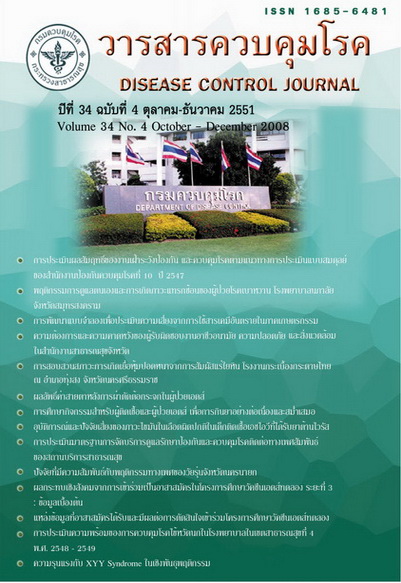Assessment on Achievement of Disease Surveillance, Prevention and Control according to Balanced Scorecard Approach of Office of Disease Prevention and Control 10, Chiang Mai
Keywords:
Performance, Assessment on Achievement, Office of Disease Prevention and Control No 10Abstract
The purpose of this study was to assess the achievement of Disease Surveillance, Prevention and Control with respect to indicator in each perspective according to a Balanced Scorecard Approach of Office of Disease Prevention and Control 10 (DDC10) and to assess participation performance according to key performance indicator (KPI)of Bureau of Budget and Office of the Public Sector Development Commission (PSDC) in Year 2004 by preparing tools and Self Assessment Report: SAR) in personal and department level for following up progress of Strategy Development of institute. From the assessment on achievement according to a Balanced Scorecard Approach of DDC 10 in 4 perspectives, it was found that the achievement in overall view of Balance Scorecard is 76.2 percents while the performance on the Customer perspective was highest as 84.2 %, Internal Process perspective as 82.3%. The Financial perspective wass only 67.7% and the lowest one was the perspective of Learning and Growth as 62.5%. For the result of achievement assessment according to framework of the Public Sector Development, all indicators were the same ones as the Balance Scorecard Approach.Regarding to the assessment result of achievement according to scorecard of the Bureau of Budget as Service Delivery Agreement (SDA), assessed against the target of performance, it was found that the performance from the Product 2: Transference of knowledge and Technology of Disease Surveillance, Prevention and Control, and Product 5: Remedy of AIDs Problem were lower than target as 86.1% and 86.3% respectively. As for the assessment on achievement of performance following policy and target of service (Public Service Agreement: PSA) of the Department of Disease Control comprising 14 indicators related to disease of the Policy as AIDs, Tuberculosis, Dengue fever, and non-communicable disease (Heart disease and Disease related to blood vessel, and accident) it was found that only 2 targets as Dengue fever and Tuberculosis were achieved. And for the indicator in process perspective, indicator reaching the target as expanding opportunity of taking care of the AIDs patient by antivirus drug was also achieved.
Downloads
References
2. อรรถชัย บุรกรรมโกวิท. การจัดทำแผนปฏิบัติการประจำปี 2546 และเทคนิคการติดตามและประเมินผลตามระบบ SPBB. เอกสารโครงการประชุมทางวิชาการ ประจำปี ครั้งที่ 5 จัดโดยสถาบันพัฒนานโยบายและการจัดการ คณะรัฐศาสตร์ จุฬาฯ, 2545.
3. คณะกรรมการพัฒนาระบบราชการ (ก.พ.ร) แผนยุทธศาสตร์การพัฒนาระบบราชการไทย (พ.ศ.2546-2550), 2546. สำนักตรวจและประเมินผล กระทรวงสาธารณสุข. คู่มือการประเมินผลภายใต้ระบบงบประมาณแบบมุ่งเน้นผลสัมฤทธิ์ กระทรวงสาธารณสุข ในช่วงแผนพัฒนาเศรษฐกิจและสังคมแห่งชาติฉบับที่ 9 (พ.ศ.2545 - 2549). เมษายน; 2546.
4. กรมควบคุมโรคติดต่อ.ดัชนีชี้วัดการประเมินผลการป้องกันควบคุมโรคและภัยสุขภาพตามแผนพัฒนาสุขภาพแห่งชาติในช่วงแผนพัฒนาเศรษฐกิจและสังคมแห่งชาติ ฉบับที่ 9 พ.ศ.2545 - 2549). กรุงเทพมหานคร.
5. สถาบันพัฒนานโยบายและการจัดการ คณะรัฐศาสตร์ จุฬาลงกรณ์มหาวิทยาลัยและภาควิชาบริหารสาธารณสุข คณะสาธารณสุขศาสตร์ มหาวิทยาลัย มหิดล . เอกสารรายงานการประเมินผลสัมฤทธิ์ของ งานเฝ้าระวังป้องกันและควบคุมโรค ตามแนวทางการประเมินแบบสมดุลย์ของกรมควบคุมโรค ปี 2547
6. Kaplan, R. and Norton, D. The Balanced Scorecard: Translating Strategy into Action. Boston: The President and Fellows of Harvard College, 1996., Miller, A and Dess, G.Strategic Management. New York: McGraw-Hill,, Inc., 1996
7. กลุ่มส่งเสริมสนับสนุนวิชาการ สำนักงานป้องกันควบคุมโรคที่ 10. เอกสารรายงานสรุปผลงานตามตัวชี้วัด Balance Scorecard ของสำนักงานป้องกันควบคุมโรคที่ 10 ปี 2547
8. กลุ่มส่งเสริมสนับสนุนวิชาการ สำนักงานป้องกันควบคุมโรคที่ 10. เอกสาร แผนกลยุทธ์ของสำนักงานป้องกันควบคุมโรคที่ 10 ปี 2546, 2547
Downloads
Published
How to Cite
Issue
Section
License
Articles published in the Disease Control Journal are considered as academic work, research or analysis of the personal opinion of the authors, not the opinion of the Thailand Department of Disease Control or editorial team. The authors must be responsible for their articles.






